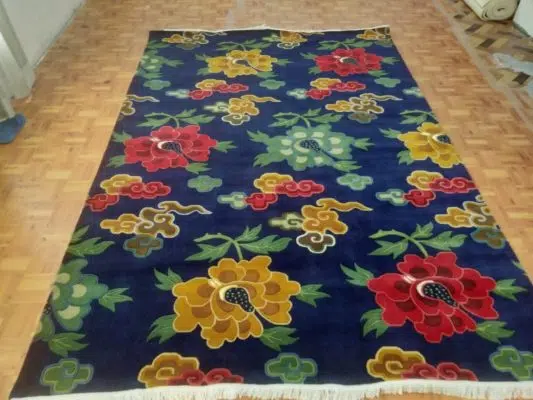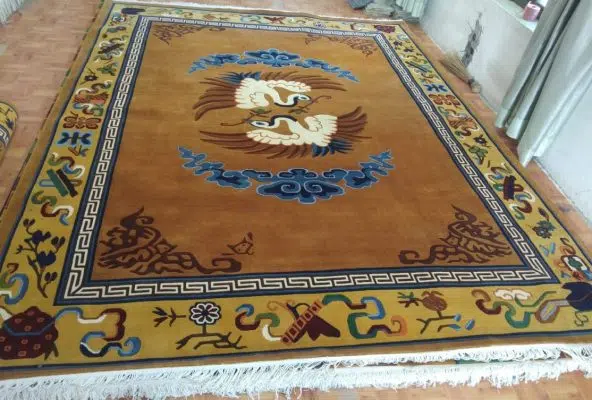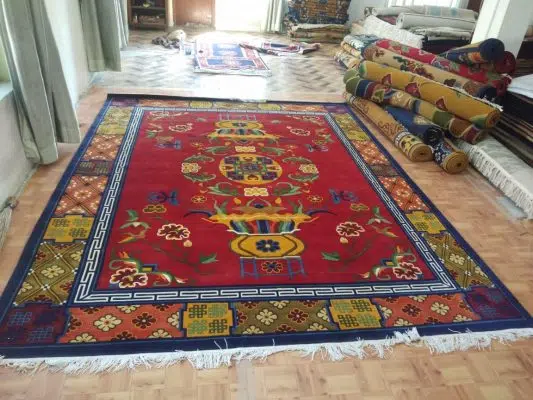Blog
Entryway Tibetan Rugs
![]()
Table of Contents
Entryway Tibetan Rugs: A Complete Guide
Introduction to Entryway Tibetan Rugs
Entryway Tibetan rugs are more than just decorative floor coverings; they are a blend of rich cultural heritage, artistry, and functionality. These rugs, often crafted by skilled artisans in the Himalayan regions, bring a touch of tradition and elegance to your home’s entryway. The unique patterns, vibrant colors, and durability of Tibetan rugs make them a popular choice for those looking to enhance the aesthetic appeal and comfort of their entryways.

History and Origin of Tibetan Rugs
Tibetan rugs have a history that dates back over 2,000 years, originating in the Tibetan plateau. These rugs were traditionally used in monasteries, homes, and for ceremonial purposes. The art of rug weaving was passed down through generations, with each rug telling a story of the weaver’s community, beliefs, and environment. Tibetan rugs were historically made from the wool of sheep native to the region, known for its softness and durability.
The Evolution of Tibetan Rugs
Over time, Tibetan rugs evolved in both design and technique. While traditional patterns and methods remain prevalent, modern Tibetan rugs now incorporate contemporary designs, catering to a global market. The transition from purely functional items to works of art reflects the adaptability and enduring appeal of Tibetan rug weaving.
Materials Used in Entryway Tibetan Rugs
Wool
The primary material used in Tibetan rugs is wool, specifically highland sheep wool, which is renowned for its softness, resilience, and natural lanolin content that makes it stain-resistant and durable. The wool used in Tibetan rugs is often hand-spun, giving the rugs a unique texture and character.
Silk
Some Tibetan rugs, especially those intended for ceremonial or high-end use, incorporate silk. Silk adds a luxurious sheen and smoothness to the rug, creating a contrast with the wool that highlights intricate designs.
Natural Dyes
Traditionally, Tibetan rugs were dyed using natural dyes extracted from plants, minerals, and insects. These natural dyes give the rugs their vibrant yet earthy tones, which are often seen in deep reds, blues, and golds. While synthetic dyes are now sometimes used, many artisans still prefer natural dyes for their authenticity and eco-friendliness.

The Tibetan Knotting Technique
One of the most distinctive features of Tibetan rugs is the knotting technique used in their creation. The Tibetan knot is unique in that the yarn is looped around a rod placed across the warp threads and then cut, creating a looped pile. This method results in a dense, durable rug with a soft, plush feel. The number of knots per square inch can vary, with higher knot counts indicating finer quality.
Durability and Longevity
Due to the high-quality materials and meticulous craftsmanship, Tibetan rugs are incredibly durable. When properly cared for, these rugs can last for decades, even in high-traffic areas like entryways. Their dense weave and the natural properties of wool make them resistant to wear and tear, stains, and fading.
Design and Symbolism in Tibetan Rugs
Traditional Patterns
Tibetan rugs often feature traditional patterns rich in symbolism. Common motifs include dragons, lotus flowers, clouds, and geometric designs. Each symbol holds cultural significance; for example, the dragon represents strength and protection, while the lotus flower symbolizes purity and spiritual awakening.
Modern Designs
In addition to traditional patterns, modern Tibetan rugs may feature contemporary designs that cater to a broader range of tastes. These rugs might include abstract patterns, minimalist designs, or a fusion of traditional and modern elements. Despite the evolution in style, the craftsmanship remains rooted in Tibetan traditions.
Choosing the Right Tibetan Rug for Your Entryway
Size Considerations
When selecting a Tibetan rug for your entryway, it’s essential to consider the size of the space. The rug should fit comfortably within the entryway, leaving enough space for doors to open and close without obstruction. Standard sizes for entryway rugs include 2×3 feet, 3×5 feet, and runner rugs that are longer and narrower.
Also visit:-
Color and Pattern Selection
The color and pattern of the rug should complement the overall décor of your home. For a cohesive look, choose a rug that matches or contrasts harmoniously with your entryway’s color scheme. Bold patterns and vibrant colors can make a statement, while neutral tones can create a calming, welcoming atmosphere.
Material and Maintenance
Consider the level of traffic in your entryway when choosing the material of your rug. Wool is an excellent choice for high-traffic areas due to its durability and ease of maintenance. Silk, while luxurious, may require more care and is better suited for less busy areas.

Caring for Your Entryway Tibetan Rug
Regular Cleaning
To maintain the beauty and longevity of your Tibetan rug, regular cleaning is essential. Vacuum your rug weekly to remove dust and dirt. Be sure to use a vacuum without a beater bar or set the vacuum on a gentle setting to avoid damaging the fibers.
Spot Cleaning
In the event of spills, prompt spot cleaning is crucial. Blot the spill with a clean, dry cloth—never rub, as this can push the stain deeper into the fibers. For stubborn stains, use a mild detergent mixed with water, and blot the area gently. Avoid using harsh chemicals, which can damage the rug’s natural fibers.
Professional Cleaning
It’s advisable to have your Tibetan rug professionally cleaned every 12 to 18 months, depending on the level of traffic it endures. Professional cleaning can remove deeply embedded dirt and restore the rug’s vibrancy.
Rotating the Rug
To ensure even wear, rotate your rug every few months. This practice is especially important in high-traffic areas like entryways, where certain spots may experience more foot traffic than others.
Where to Buy Authentic Tibetan Rugs
Specialty Stores
Specialty stores that focus on Tibetan or Oriental rugs are excellent places to find authentic Tibetan rugs. These stores often have knowledgeable staff who can provide detailed information about the rugs’ origins, materials, and craftsmanship.
Online Retailers
Several online retailers offer a wide selection of Tibetan rugs, ranging from traditional to modern designs. When buying online, ensure the retailer is reputable and provides detailed descriptions and images of the rugs.
Directly from Artisans
Purchasing a Tibetan rug directly from artisans or cooperatives ensures authenticity and supports the local communities involved in rug weaving. Many artisans now sell their products online or through specialty markets.
Also visit:-
The Cultural Significance of Tibetan Rugs
Spiritual and Symbolic Meanings
Tibetan rugs are deeply intertwined with the spiritual and cultural practices of the Tibetan people. The symbols and patterns found in these rugs often reflect Buddhist beliefs and teachings. For instance, the endless knot, a common motif, symbolizes the interconnectedness of all things and the cycle of life.
Tibetan Rugs in Modern Homes
While Tibetan rugs hold cultural significance, they have also found a place in modern homes worldwide. Their unique designs and craftsmanship make them a favored choice for homeowners looking to add a touch of tradition and elegance to their interiors. Whether used as an entryway piece or a centerpiece in a living room, Tibetan rugs offer both aesthetic and cultural value.
Custom Tibetan Rugs for Entryways
Personalization and Customization
Many artisans and retailers offer customization options for Tibetan rugs, allowing you to choose specific colors, patterns, and sizes that fit your entryway perfectly. Custom rugs can also incorporate personal symbols or motifs that hold special meaning to you.
Ordering a Custom Tibetan Rug
When ordering a custom Tibetan rug, it’s essential to communicate your preferences clearly. Provide accurate measurements of your entryway and discuss the design elements you want to include. Custom rugs typically take several weeks to months to complete, depending on the complexity of the design and the availability of materials.
The Environmental Impact of Tibetan Rugs
Sustainable Materials
Tibetan rugs are often made from sustainable materials such as wool, which is a renewable resource. The use of natural dyes also reduces the environmental impact compared to synthetic alternatives.
Supporting Ethical Practices
By purchasing Tibetan rugs, especially those made by artisans or cooperatives, you support ethical practices and fair wages for the weavers. Many organizations work to ensure that the traditional art of rug weaving continues in a sustainable and fair manner.
Also visit:-
Conclusion: Enhancing Your Home with Entryway Tibetan Rugs
Entryway Tibetan rugs are more than just a decorative element—they are a blend of history, culture, and craftsmanship. Whether you’re drawn to the traditional patterns that reflect centuries-old Tibetan symbolism or prefer modern designs that fit contemporary interiors, a Tibetan rug can enhance the beauty and comfort of your entryway. By choosing a high-quality, authentic Tibetan rug, you’re investing in a piece of art that will not only serve as a functional element in your home but also as a conversation starter, a symbol of cultural appreciation, and a lasting legacy of traditional craftsmanship.
FAQs on Entryway Tibetan Rugs:
1. What are Entryway Tibetan Rugs?
Entryway Tibetan rugs are handcrafted rugs made by skilled artisans in the Himalayan regions. These rugs are specifically designed to be used in entryways, providing both aesthetic appeal and functional durability.
2. What makes Tibetan rugs unique?
Tibetan rugs are unique due to their traditional knotting techniques, high-quality materials such as wool and silk, and intricate designs that often incorporate symbolic motifs rooted in Tibetan culture.
3. How are Entryway Tibetan Rugs made?
These rugs are made using a hand-knotting technique known as the Tibetan knot, which involves looping yarn around rods and cutting it to create a plush, dense pile. The process is labor-intensive and can take weeks to complete depending on the rug’s size and complexity.
4. What materials are used in Entryway Tibetan Rugs?
The primary material used is highland sheep wool, known for its softness and durability. Some rugs also incorporate silk for added sheen and texture. Natural dyes are often used to achieve the vibrant colors.
5. Are Entryway Tibetan Rugs durable?
Yes, Tibetan rugs are known for their durability. The high-quality wool and tight knotting make them resistant to wear and tear, making them ideal for high-traffic areas like entryways.
6. What sizes are available for Entryway Tibetan Rugs?
Common sizes for entryway rugs include 2×3 feet, 3×5 feet, and runner rugs, which are longer and narrower. Custom sizes can also be ordered to fit specific entryway dimensions.
7. How do I choose the right size for my entryway?
Measure your entryway to determine the best rug size. The rug should fit comfortably within the space, leaving enough room for doors to open and close without obstruction.
8. What patterns are commonly found in Tibetan rugs?
Traditional Tibetan rugs feature patterns such as dragons, lotus flowers, clouds, and geometric designs. Modern versions may include abstract or minimalist patterns that blend traditional and contemporary styles.
9. Can I customize my Entryway Tibetan Rug?
Yes, many artisans offer customization options, allowing you to choose specific colors, patterns, and sizes that fit your entryway. Custom rugs can also include personal symbols or motifs.
10. How do I clean and maintain an Entryway Tibetan Rug?
Regular vacuuming and prompt spot cleaning are essential. Avoid using harsh chemicals. It’s also recommended to have your rug professionally cleaned every 12 to 18 months.
11. Are Tibetan rugs eco-friendly?
Yes, many Tibetan rugs are eco-friendly as they are made from sustainable materials like wool and natural dyes. By purchasing these rugs, you also support ethical practices and fair wages for artisans.
12. Do Tibetan rugs fade over time?
With proper care, Tibetan rugs maintain their color and vibrancy for many years. However, exposure to direct sunlight for prolonged periods can cause some fading, so it’s advisable to keep the rug out of direct sunlight.
13. Can I use a Tibetan rug in a high-traffic area like an entryway?
Yes, Tibetan rugs are well-suited for high-traffic areas due to their durability. The dense weave and resilient wool make them ideal for entryways.
14. How often should I rotate my Entryway Tibetan Rug?
It’s recommended to rotate your rug every few months to ensure even wear, especially in high-traffic areas like entryways.
15. What are the benefits of using a Tibetan rug in my entryway?
Tibetan rugs add a touch of cultural elegance, warmth, and comfort to your entryway. They also protect your flooring and can reduce noise.
16. How do I know if a Tibetan rug is authentic?
Authentic Tibetan rugs are handmade using traditional techniques and materials. Look for a dense weave, vibrant natural dyes, and traditional patterns. Buying from reputable sellers or directly from artisans helps ensure authenticity.
17. Can I use an underlay or rug pad with my Tibetan rug?
Yes, using a rug pad is recommended to prevent slipping, add cushioning, and protect both the rug and your flooring.
18. Are Entryway Tibetan Rugs expensive?
The cost of a Tibetan rug can vary based on size, materials, and complexity of the design. While some rugs may be more expensive due to their craftsmanship and quality, there are options available at different price points.
19. Where can I buy Entryway Tibetan Rugs?
Tibetan rugs can be purchased from specialty stores, online retailers, and directly from artisans or cooperatives that support traditional rug weaving practices.
20. Can Entryway Tibetan Rugs be used outdoors?
Tibetan rugs are generally not recommended for outdoor use due to their delicate materials. However, they can be used in covered outdoor areas with minimal exposure to the elements.
21. What are the cultural symbols found in Tibetan rugs?
Common symbols include the endless knot (interconnectedness of all things), the lotus (purity), and dragons (strength and protection). These symbols often reflect Buddhist teachings and Tibetan cultural beliefs.
22. How long does it take to make a Tibetan rug?
The time to make a Tibetan rug depends on its size and complexity. It can take anywhere from a few weeks to several months to complete a single rug.
23. Can I use a Tibetan rug in a modern interior?
Yes, Tibetan rugs can complement both traditional and modern interiors. Their unique patterns and colors add character to any space, whether it’s a contemporary or traditional home.
24. What is the significance of the colors in Tibetan rugs?
The colors used in Tibetan rugs often have symbolic meanings. For example, red may symbolize protection, blue can represent wisdom, and gold signifies prosperity.
25. How do I store an Entryway Tibetan Rug when not in use?
When storing your rug, roll it (do not fold) and wrap it in a breathable fabric like cotton or muslin. Store it in a cool, dry place away from direct sunlight and humidity to prevent damage.
Contact Us:-
ADDRESS
Loktantrik Chowk, Nakhipot-14, Lalitpur, Nepal
CONTACT HOURS
Sunday to Saturday 24/7
E-MAIL yuna.handicrafts@gmail.com
PHONE +977 9851-131344 (WhatsApp)


